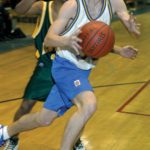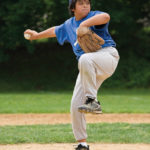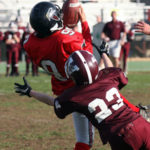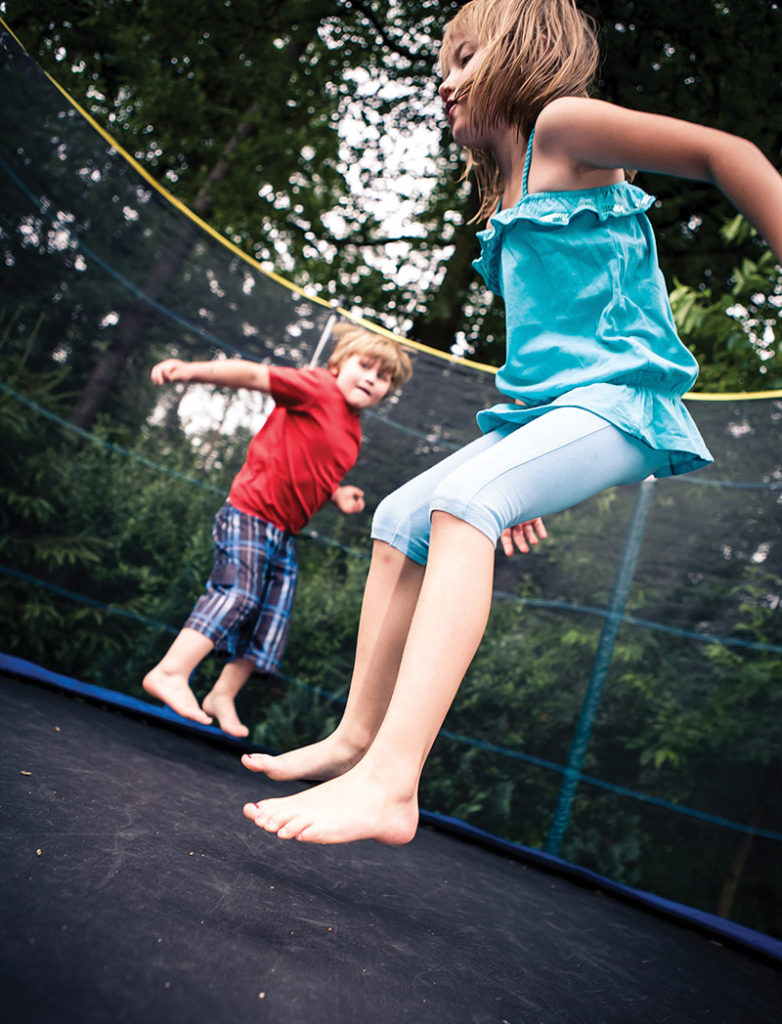 Trampoline use, both in backyards and in large recreational parks, is up. So are injuries incurred on the equipment, including fractures with potentially serious long-term sequelae. Some groups advise a ban on home use, but other experts disagree, citing the equipment’s benefits for motor learning and active play.
Trampoline use, both in backyards and in large recreational parks, is up. So are injuries incurred on the equipment, including fractures with potentially serious long-term sequelae. Some groups advise a ban on home use, but other experts disagree, citing the equipment’s benefits for motor learning and active play.
By P.K. Daniel
The late George Peter Nissen fashioned a canvas sheet to a rectangular steel frame in his parents’ garage nearly a century ago to create the world’s first bouncing apparatus, which he later called the trampoline. It’s doubtful, however, that he had in mind toddlers jumping or multiple children bouncing simultaneously, scenarios that often result in lower extremity injury.
Despite repeated warnings from the American Academy of Pediatrics (AAP) about the dangers of the trampoline, its popularity hasn’t waned. More than one million people suffered a trampoline injury resulting in an emergency department (ED) visit between 2002 and 2011, according to a national database study.1
“We see fractures from trampoline injuries almost every week in the summer months,” said Aaron J. Provance, MD, medical director of the Pediatric Sports Medicine Program in the Department of Orthopedics at Children’s Hospital Colorado in Aurora.
The national database study, conducted by researchers at Indiana University in Indianapolis, used the Consumer Product Safety Commission’s National Electronic Injury Surveillance System (NEISS) to look at trampoline-related fracture patterns across a large population. The results, published in 2014 in the Journal of Pediatric Orthopaedics, noted that 29% of the trampoline injuries were fractures, and more than a third (35.7%) occurred in the lower extremity.1
Although 51.7% of those who suffered fractures were male, more female patients (54%) suffered lower extremity fractures. Nearly 93% of all fractures occurred in patients 16 years or younger (average age 9.5 years).1
There were nearly 105,000 ED visits in 2014 for trampoline injuries, according to Bob Segall, an investigative reporter at television station WTHR in Indianapolis, who in February reported on his analysis of NEISS data. In comparison, there were slightly more than 66,000 trampoline injuries requiring ED treatment in 1995.2
At least one study attributes the rise in injuries to an increase in trampoline sales, and, subsequently, in participation.3
Who’s at risk?
The type of trampoline injury varies with age and size, but the youngest, smallest kids are at the greatest risk.
“Younger and smaller children are much more likely to sustain fractures of all types,” said Michele LaBotz, MD, FAAP, a member of the national executive committee for the AAP’s Council on Sports Medicine & Fitness, who practices at InterMed in South Portland, ME.
The AAP reported that smaller, typically younger children are 14 times more likely to incur injuries than larger children.4
Segal at WTHR also reported the majority (85%) of the 2014 ED visits for trampoline injuries recorded in the NEISS database involved children; those aged 2 to 5 years accounted for a quarter of the visits. And 42% of the injuries suffered by toddlers and preschoolers were bone fractures.
Although the AAP and the American Academy of Orthopaedic Surgeons maintain that the majority of trampoline injuries occur in home environments, the proliferation of trampoline parks is another source of injuries. There was a staggering 700% growth in trampoline parks between 2011 and 2014, according to the International Association of Trampoline Parks, which itself was established only in 2012. These parks cater to kids—even those who are very young.
Many parks lack oversight. Arizona and Michigan are the only states with specific laws related to trampoline safety, and there are zero federal regulations for trampoline parks.
“With the increased number of companies having indoor trampolines, the injury rates may be similar to home-based trampolines,” said Provance. “Future research needs to be completed in this area.” LaBotz also said that, due to a lack of data, it’s unclear which setting–trampoline parks (with wall-to-wall and between-bed padding) or backyard home trampolines (some with safety nets)–results in more injuries.5
Anecdotally, however, LaBotz said sports medicine and ED doctors have noted marked increases in trampoline-specific injuries in geographic areas where trampoline parks have opened. “Visits to these trampoline parks often show an impressive list of rules and regulations upon entry, but enforcement of these policies [especially with regard to limiting numbers of jumpers on a mat] is highly variable,” she said.
Despite repeated warnings by the AAP that children younger than 6 years are at an increased risk of fractures and dislocations and should not use trampolines, trampoline parks offer programs, with such names as Rockin’ Tots and Toddler Time, specifically geared to this age group.
“[Toddlers’] lack of balance and muscle strength make them much more susceptible to more severe injury, especially in cases involving multiple simultaneous users,” said LaBotz. “Forces associated with rebound on the soft trampoline mat are far greater than forces that are generated by a fall onto hard ground, especially for smaller children.”
The multiple-jumper problem
About 75% of injuries occur when multiple people use the trampoline at once, according to a Consumer Product Safety Review, which the AAP reported in its 2012 policy statement and reaffirmed in 2015.4 When larger children are bouncing with smaller ones, they generate more recoil of the trampoline bed and more impact forces than smaller users can generate independently.4
Larger people on the trampoline bed sometimes “rocket propel” smaller children. In other words, they send the kids much higher in the air than they could go on their own. When they fall onto the mat, they fall from a greater height than they otherwise would, while the trampoline bed recoils upward at the same time.
NEISS database study coauthor Randall T. Loder, MD, chair of Indiana University’s Department of Orthopaedic Surgery, told LER: Pediatrics: “[In] my anecdotal experience taking care of many of these children, there is often more than one person on the trampoline, and there is the double-hit phenomenon—the child hits the trampoline when the other child is landing, doubling the force.”
Provance noted that tibia fractures commonly occur when a larger child or adult is rebounding upward and a smaller child is landing simultaneously on the trampoline, causing a significant compression force to the lower extremity. If this compression force is large enough, the top of the tibia can incur a buckle or compression fracture.
Injuries
Provance said most of the trampoline injuries he sees at the Sports Medicine Center at Children’s Hospital in Colorado are fractures of the upper and lower extremities. “The more serious injuries typically involve fractures at the top of the [tibia],” he said. “These fractures can have a risk of long-term complications. Even after these fractures have healed, there is a risk of further angulation of the leg months to years down the road.” 6,7
LaBotz said one of the main risks with these injuries is a lack of recognition. Presentation depends on the site of the injury. For example, physicians don’t typically look for a buckle fracture, which is an incomplete fracture in which one side of the bone is compressed, causing the other side to bend, in the proximal tibia, she said.
“Some of these injuries are rarely seen outside of trampoline-associated trauma, and providers might not be aware of the usual patterns of presentation,” LaBotz added. “One of the most common of these missed injuries is the metaphyseal fracture seen in the proximal tibia of young children. This is commonly a ‘torus-type’ of injury, which sometimes seems to escape recognition even by experienced radiologists, although once it is appropriately treated it heals well.”
Trampoline ankle
“Trampoline-related growth-plate fractures to the young ankle can be particularly severe and often require acute surgical intervention,” said LaBotz. “These injuries are at high risk for future growth arrest, which can be very problematic in the younger population.”
Paul Moroz, MD, a pediatric orthopedic and spine surgeon at Shriners Hospitals for Children in Honolulu, HI, agreed. He and colleagues addressed “trampoline ankle” in a study they conducted at the University of Ottawa in Canada and first published online in November 2015 in The Journal of Pediatric Orthopaedics.8
Moroz told LER: Pediatrics in its February issue that multiple jumpers are the primary cause of trampoline ankle (see “Multiple jumpers increase risk for trampoline ankle,” page 7). This injury involves the growth plates at the lowest part of the tibia and fibula, just above the ankle joint, making it unique to children.8
Just like the tibia fractures that Provance described as the result of compression forces, Moroz described how, when two individuals bounce out of sync, kinetic energy forces are generated that produce a high-impact effect. For youngsters this can cause serious distal as well as proximal growth-plate injuries that can result in long-term consequences, such as growth arrest. 6,7
Because there is a broad spectrum of injuries associated with trampoline use, treatments range from simple bracing or splinting performed in emergency or outpatient settings to injuries that require hospitalization and potential surgical intervention.
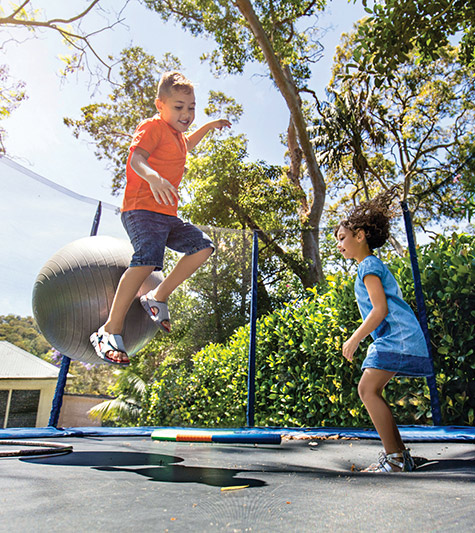 Improving safety
Improving safety
There doesn’t seem to be a difference in the severity or prevalence of injury with the use of padding, netting, or other safety measures. The AAP has reported that the introduction of netting and other safety equipment in the late 1990s and early 2000s has not reduced injury rates.4 Many injuries occur on the bed itself, where padding or netting can’t mitigate injury risk. In addition, LaBotz said many suburban neighborhoods have trampolines with nets and padding that are inappropriately installed, in poor repair, or both.
Another problem, she said, with “safety nets” is the often false perception of protection they can produce. They may, for example, entice users to take additional risks on the apparatus; falsely assure parents and other adults that supervision is not needed; and can be additional sources of injury, particularly if children try to climb netting or get body parts caught in the netting while jumping, all of which is why the AAP continues to advise against using backyard trampolines.
Not everybody is on the trampoline ban bandwagon, however. Norwegian researchers don’t support the AAP’s position. Instead, they advocate using the trampoline for lower extremity exercise to help children develop motor skills, strength, and balance.
In a 2006 issue of the British Journal of Sports Medicine, orthopedic surgeons from Trondheim, Norway, wrote: “Several reports on trampoline injuries recommend a ban on private, recreational trampoline use for children. We do not, for several reasons, support such a ban. Jumping on a trampoline gives children the ability to improve their motor control. It may also increase physical activity.”9
Although the Norwegian researchers stressed the importance of being aware of trampoline-associated risks, they concluded the effects of inactivity outweigh the risks of trampoline use.
LaBotz agreed with the Norwegians. She said there is an intrinsic risk associated with any form of physical activity—everything from bicycling to football can be associated with higher rates of acute injury compared with sitting on the sofa.
“But, if sitting on the sofa is all someone does, it will certainly contribute to one’s early demise over the longer term,” she said. “This risk-benefit balance will vary depending upon the nature of the activity itself, as well as of the population participating in it. Home trampolines are probably best compared to home swimming pools, in that they are very appealing and fun for many young kids, but, if not used appropriately and with adult supervision [supervision that is engaged and on site, not just peeking out the kitchen window], can be very hazardous. Our main concern at the AAP is not with trampolines per se, but with inappropriate use, and the current cultural perception and marketing of trampolines as toys.”
Athletes, including gymnasts, divers, figure skaters, freestyle skiers, and the like, use the trampoline as an intrinsic part of learning certain skills. However, this training is done with trampolines that differ from those used by the public; it also includes dedicated and experienced spotting and oversight that make the risks associated with this activity much lower than with recreational home trampoline use.
There are steps, however, that the US Consumer Product Safety Commission recommends to reduce serious injuries.4
They include: limiting use to one person at a time; not attempting flips; keeping springs covered with padding; not placing trampolines near trees or other structures; not allowing children younger than 6 years on the trampoline; providing adult supervision at all times; placing an enclosure to prevent falls to the ground; and not placing a ladder near the trampoline.
“Trampolines were initially designed for training acrobats and military aviators, and can be a very helpful part of a structured and well-supervised athletic training program, but they are not toys,” said LaBotz.
Although not directly related to the lower extremity, LaBotz emphasized that .5% of trampoline injuries result in permanent neurologic sequelae, such as paralysis or paresis to the upper or lower extremities or both resulting from cervical spine injury.10
“While this one-in-two-hundred rate may seem low, given the severity of consequences and the overall numbers of trampoline-related injuries, it is important to keep in mind,” she said. “The most common mechanism of cervical spine injury on the trampoline is due to failed attempts at aerial [front or back] somersaults or flips.”
The Indiana University study numbers confirm the frequency of trampoline injuries presenting to EDs, but the problem is more widespread, and the actual figures are likely much higher, LaBotz noted.
“This likely reflects significant under-reporting, in that many of these injuries [particularly with the high cost associated with ED care] will present to their primary care provider or to urgent care/walk-in other outpatient facilities for evaluation and treatment,” said LaBotz. “These injuries are not currently captured in NEISS or other large databases that are often used as information sources for these epidemiology studies.”
- Loder R, Schultz W, Sabatino M. Fractures from trampolines: results from a national database, 2002 to 2011. J Pediatr Orthop 2014;34(7):683-690.
- National Electronic Injury Surveillance System (NEISS). 1995 NEISS data. Consumer Product Safety Commission website. http://www.cpsc.gov/en/Research–Statistics/NEISS-Injury-Data/. Accessed May 10, 2016.
- Königshausen M, Gothner M, Kruppa C, Dudda M, et al. Trampoline-related injuries in children: an increasing problem. Sportverletz Sportschaden. 2014;28(2):69-74. [Epub 2014 Jun 25].
- Briskin S, LaBotz M. Trampoline safety in childhood and adolescence. Council on Sports Medicine and Fitness, American Academy of Pediatrics. Pediatrics 2012;130(4):774-779. Reaffirmed July 2015.
- Alexander K, Eager D, Scarrott C, Sushinsky G. Effectiveness of pads and enclosures as safety interventions on consumer trampolines. Inj Prev 2010;16(3):185-189.
- Caine D, DiFiori J, Maffulli N. Physeal injuries in children’s and youth sports: reasons for concern? BR J Sports Med 2008;40:749-760.
- Lalonde KA, Letts M. Traumatic growth arrest of the distal tibia: a clinical and radiographic review. Can J Surg 2005;48(2):143-147.
- Blumetti F, Gauthier L, Moroz P. The ‘trampoline ankle’: severe medial malleolar physeal injuries in children and adolescents secondary to multioccupant use of trampolines. J Pediatr Orthop B 2016;25(2):133-137.
- Nysted M, Drogset J. Trampoline injuries. Br J Sports Med 2006;40(12):984-987.
- Brown PG, Lee M. Trampoline injuries of the cervical spine. Pediatr Neurosurg 2000;32(4):170-175.


